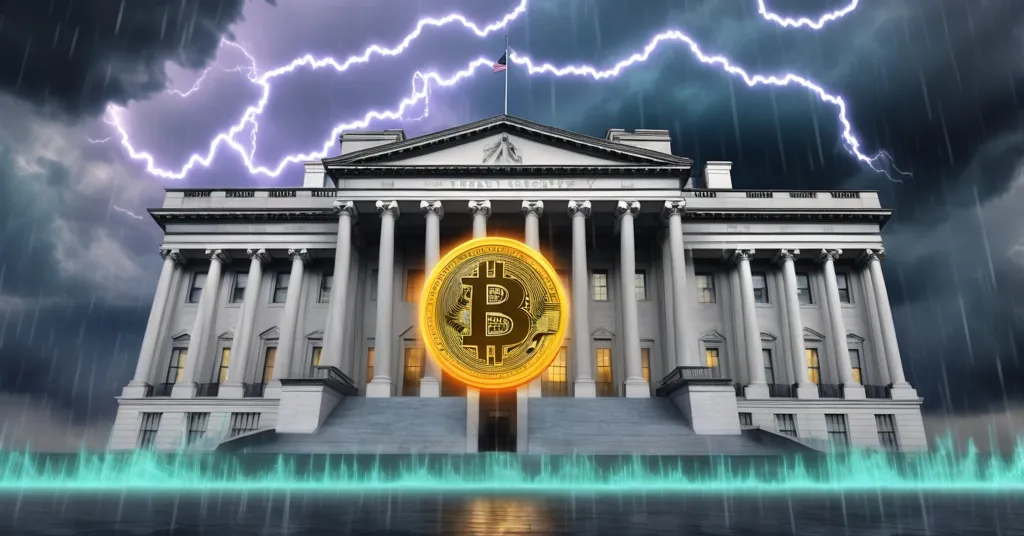U.S. Treasury Eyes Bitcoin Reserve Growth: Strategic Move or Market Risk?

U.S. Treasury Targets Bitcoin Reserve Expansion: Bold Leap or Risky Bet?
The U.S. government has dropped a bombshell that’s got the crypto world buzzing: Treasury Secretary Scott Bessent has reversed course, announcing that the U.S. may boost its Bitcoin holdings for the Strategic Bitcoin Reserve. This comes just hours after he shot down the idea of additional purchases, leaving markets rattled and enthusiasts both thrilled and skeptical.
- Stunning Reversal: Scott Bessent now backs budget-neutral Bitcoin acquisitions for the Strategic Bitcoin Reserve, a day after rejecting further purchases.
- Reserve Snapshot: Valued at $15-20 billion, the reserve was created under President Trump’s March Executive Order with forfeited Bitcoin.
- Market Jolt: Bitcoin’s price slipped from $124,000 to around $119,000 post-announcement, hinting at investor unease.
This isn’t just political posturing—it’s a move with profound implications for Bitcoin’s role in global finance. Let’s break it down with the clarity and grit this space demands.
Behind the Policy Flip-Flop
The Strategic Bitcoin Reserve, set up through President Trump’s executive order on March 6, marks a historic shift in how the U.S. views Bitcoin. Built from forfeited assets—think Bitcoin seized from criminal operations like the Silk Road busts—this reserve holds an estimated 198,000 BTC, worth between $15 billion and $20 billion depending on market swings. Some data pegs it closer to $23.5 billion at current prices, but volatility keeps that figure a moving target. The stated goal is to cement U.S. dominance in the cryptocurrency sphere, treating Bitcoin like a strategic asset on par with gold or oil.
Bessent’s initial stance, aired on FOX Business, was a firm “no” to buying more Bitcoin, triggering an instant market reaction. Within 40 minutes, Bitcoin’s price plummeted from $121,000-$124,000 to roughly $119,000, erasing $55 billion in market cap—the total value of all Bitcoin in circulation. That’s equivalent to the GDP of a small nation vanishing in less time than it takes to brew coffee. Yet, in a swift pivot via a post on X, Bessent clarified the Treasury’s intent to explore “budget-neutral pathways” (meaning no new taxpayer money is spent) to grow the reserve. This about-face, detailed in recent expert analysis on Bessent’s policy shift, isn’t mere damage control; it signals a calculated push to strengthen national influence in digital asset markets without stirring fiscal backlash.
For those new to the space, budget-neutral could involve using more forfeited Bitcoin from criminal seizures, reallocating existing government resources, or even creative financial tools like reevaluating gold certificates (government-issued documents representing ownership of gold held in reserves). White House crypto advisor David Sacks and Commerce Secretary Howard Lutnick are tasked with ensuring these acquisitions don’t burden taxpayers, though the specifics remain under wraps. It’s a pragmatic nod to fiscal restraint in a polarized political climate where every expenditure is a lightning rod.
Market Reactions and Investor Doubts
Let’s cut through the hype: the market isn’t buying this as an unalloyed win. The dip to $119,000 post-announcement reflects a cautious, if not jittery, investor sentiment, with insights on this volatility captured in community discussions about government Bitcoin purchases. Are traders spooked by the Treasury’s whiplash messaging, or do they fear government meddling in a space rooted in decentralization? Likely a mix of both. There’s also the specter of future government actions—what if the U.S. unloads chunks of its Bitcoin stash during price spikes, flooding the market and tanking values? That uncertainty could be as toxic as any policy misstep.
Industry voices aren’t holding back either. Eli Nagar, CEO of Braiins, tore into the Treasury’s pace, saying:
“Are you seriously still ‘exploring budget-neutral pathways’? At some point, exploration without execution starts to look like avoidance.”
Translation: less dithering, more action—before Bitcoin’s price takes another nosedive. Nagar’s jab highlights a brutal truth in crypto: hesitation costs billions. This isn’t a space for endless committee meetings; it’s a battlefield where speed often dictates survival.
Geopolitical Stakes in the Crypto Race
Zooming out, the U.S. isn’t playing this game solo. Nations like El Salvador have already made Bitcoin legal tender (meaning it’s usable for everyday transactions like cash), setting a bold precedent with state-backed adoption and even issuing Bitcoin bonds to fund infrastructure. Rumors swirl that Russia might be eyeing Bitcoin reserves as a hedge against sanctions, while China’s digital yuan pushes a state-controlled alternative to decentralized crypto. If the U.S. drags its feet, it risks ceding economic clout in the digital age—a point of concern for crypto advocates like Senator Cynthia Lummis, who’s championing the BITCOIN Act to streamline reserve expansion. The broader geopolitical implications of such reserves are worth exploring for a deeper understanding.
Yet, there’s a flip side to this government involvement that needs airing. Does heavy-handed U.S. accumulation clash with Bitcoin’s core ethos of decentralization? Critics on platforms like Reddit argue it’s a double-edged sword: a nation-state hoarding Bitcoin could validate its legitimacy but also centralize influence over a system designed to evade such control, as seen in online debates about Bessent’s policy reversal. As Bitcoin purists, we’d counter that if it drives adoption—turning Bitcoin into the world’s backbone currency—even Satoshi Nakamoto might begrudge a nod. Still, the tension between state power and crypto’s rebel spirit looms large.
Challenges and Risks Ahead
Don’t get too starry-eyed just yet. Expanding the Strategic Bitcoin Reserve faces a gauntlet of hurdles. For one, congressional approval is often needed for budget-neutral strategies, and getting anything through a divided Capitol Hill is like teaching a cat to fetch—good luck with that. Legislative delays could stall momentum, leaving the Treasury’s plans as little more than a press release. Senator Lummis’s push for the BITCOIN Act underscores these barriers, with progress tied to political willpower. Updates on the current state of the reserve, valued at $15-20 billion in holdings, shed light on the scale of this endeavor.
Then there’s execution risk. How will the Treasury secure these massive Bitcoin holdings? Are they using cold storage (offline wallets for maximum security) or multisig setups (requiring multiple keys to authorize transactions)? A hack or mismanagement could turn a strategic win into a national embarrassment—imagine billions in Bitcoin vanishing into a cyber black hole. Past U.S. handling of seized Bitcoin, often auctioned off as in the 2014 Silk Road sales, contrasts sharply with today’s “hold as reserve” mindset, raising questions about whether the government has the technical chops to manage this asset long-term.
Another provocative angle comes from online discussions: is U.S. Bitcoin stockpiling a silent admission of dollar weakness? If the issuer of the world’s reserve currency is hedging with a decentralized asset, what does that signal about inflation or fiat stability? Some see it as the loudest inflation warning yet, clashing with the official line of “strengthening financial leadership.” We’d argue it’s pragmatic diversification—Bitcoin as hard money that no printing press can dilute—but the critique, echoed in forums discussing Bessent’s evolving stance, stings enough to warrant debate.
Altcoins on the Horizon? A Speculative Debate
Amidst this Bitcoin focus, whispers within the Trump administration suggest a broader digital asset strategy might one day include Ethereum, Solana, XRP, or Cardano. To be clear, the Strategic Bitcoin Reserve is Bitcoin-only for now, with a separate U.S. Digital Asset Stockpile managing forfeited non-Bitcoin assets and no plans for additional buys beyond seizures. Still, the idea of diversification sparks heated discussion. Bitcoin maximalists, ourselves included, might scoff—why dilute the king’s throne with altcoin pretenders? Bitcoin’s proven store-of-value status trumps all. The potential for further Treasury Bitcoin acquisitions remains the focal point of current policy.
Yet, there’s a case for innovation. Ethereum’s smart contracts power decentralized apps and finance (DeFi) in ways Bitcoin wasn’t built for, while Solana’s lightning-fast transactions cater to high-volume use cases. Including them could signal U.S. embrace of blockchain’s full spectrum, not just one coin. The risk? Losing strategic clarity and spreading resources thin. For now, it’s purely hypothetical, but the debate underscores a broader question of where government focus should lie in this financial revolution.
Critical Questions on the U.S. Bitcoin Reserve
- What’s the purpose of the Strategic Bitcoin Reserve?
It’s a U.S. initiative to manage government-held Bitcoin, currently worth $15-20 billion, as a strategic asset to amplify national influence in global crypto markets and signal acceptance of digital currencies. - Why did Scott Bessent flip his stance on Bitcoin purchases?
Likely driven by the need to keep the U.S. competitive in the crypto race, Bessent shifted to support budget-neutral acquisitions, reflecting strategic and geopolitical pressures despite initial pushback. - How could this policy shape Bitcoin’s price and perception?
Short-term, the price dip to $119,000 shows investor caution over policy wobbles, but long-term government backing might boost legitimacy and stabilize value—if execution doesn’t falter, as noted in analysis of Treasury holdings’ market impact. - Does U.S. Bitcoin accumulation hint at dollar instability?
Critics suggest it’s a hedge against inflation and dollar devaluation, potentially undermining fiat confidence, while others view it as smart diversification in a digital-first economy. - Should the reserve ever include altcoins like Ethereum?
A Bitcoin-only focus keeps the strategy sharp and prioritizes the most battle-tested asset, but altcoins could highlight broader blockchain utility—though it risks muddling the mission.
Love it or hate it, the U.S. Treasury’s push to expand the Strategic Bitcoin Reserve could turbocharge Bitcoin’s path to mainstream dominance, flaws and all. It’s a high-stakes gamble in uncharted waters—will the U.S. emerge as the ultimate Bitcoin whale, or is this a whale of a blunder waiting to surface? One thing’s certain: every move reshapes the game, balancing raw innovation against undeniable risk.



